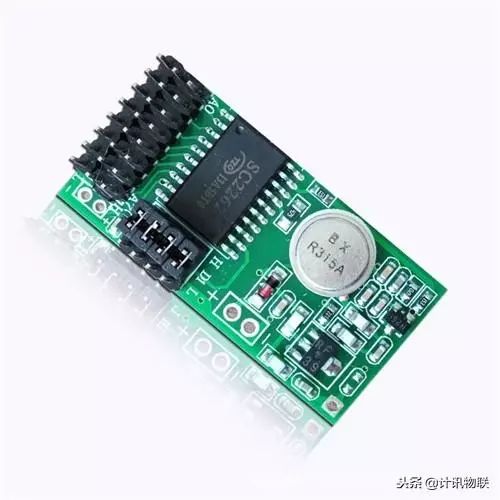1. What is the 433m Wireless Module
The 433MHz wireless transceiver module uses high-frequency RF technology, also known as the RF433 radio frequency small module. It consists of a single IC RF front end produced by All Digital Technology and an ATMEL AVR microcontroller, capable of high-speed data signal transmission. This miniature transceiver packages, error detects, and corrects the data for wireless transmission. All components are made to industrial-grade standards, ensuring stable and reliable operation, and its small size facilitates installation. It is widely applicable in fields such as security alarms, wireless automatic meter reading, home and industrial automation, remote control, and wireless data transmission.
2. Choosing an Antenna for the 433m Wireless Module
The 433m wireless module is low power consumption and powerful, widely used in fields such as robot control, smart homes, and wireless meter reading. The product is designed for industrial use, suitable for outdoor harsh environments. When users find the transmission distance insufficient during use, it is often recommended to choose a suitable antenna to increase communication distance. So, which antenna is best for the 433 wireless module?
The antenna is a crucial component of the communication system, and its performance directly affects the system’s metrics. When selecting an antenna, one must pay attention to its performance. Additionally, the gain of the antenna is one of the important indicators, representing the product of the directional coefficient and efficiency, indicating the strength of the antenna’s radiation or reception of radio waves.
3. Which Antenna to Use for the 433m Wireless Module
Generally, the antenna impedance required for common wireless modules is 50 ohms. The 433 wireless module can use general 433MHz spring antennas, elbow/straight rod antennas, suction cup antennas, etc. These antennas are specially designed for 433MHz wireless communication systems, with good standing wave ratio performance, clever structure, easy installation, stable performance, and excellent vibration resistance and aging capability. Users can choose antennas based on their application environment. To ensure the module operates at its best, it is advisable to consult the manufacturer before purchase if unsure about which antenna to select.

4. Factors Affecting the Transmission Distance of the 433m Wireless Module
After customers purchase the 433m wireless transmission module from manufacturers, they may find that the transmission distance is shorter than what is described in the product introduction, which could lead to improper usage. Experienced users know that the actual distance will be shorter than the product’s advertised range. Below are the factors affecting the transmission distance of wireless transmission modules and how to improve it:
1. The transmission distance advertised by the manufacturer is based on tests conducted in open areas with good conditions. The environment where customers use the product may have more interference, such as walls of buildings and trees. To increase the transmission distance, it is advisable to use the module in areas with fewer obstacles.
2. The power supply voltage may decrease after a period of use, leading to reduced transmission distance. To enhance transmission distance, consider replacing it with a power supply that has a larger capacity and stable voltage.
3. Some users may increase the rate of the 433 wireless module to reduce transmission time, which can lead to a decrease in transmission distance. Therefore, reducing the transmission rate can help increase the wireless module’s transmission distance.
4. The antenna is one of the factors affecting the module’s transmission distance. A high-gain antenna can extend the transmission distance. Additionally, raising the antenna’s installation height to at least 2 meters above the ground can achieve better transmission distances.
5. Applications of the 433m Wireless Module
1. Smart Home
The development and advancement of smart homes have led to an increasing number of smart home terminal products, creating a market for 433MHz wireless modules for data transmission. Smart home temperature controllers are commonly used products that can automatically adjust the temperature during different times of the day, eliminating the embarrassment of feeling cold indoors in winter and providing users with a better living environment. The wireless market is mainstream, with 433MHz wireless modules primarily used for temperature control solutions.
2. Smart Home LED Light Remote Control
Many people may think of using 2.4G wireless modules for smart home LED light remote control, but the 433M wireless module still has its advantages in long-distance remote control of smart home LED lights.
3. Wireless Smoke Detectors
In the security field, with the continuous advancement of safe city construction, more and more monitoring points are under surveillance. Timely alerts are issued for smoke emitted from various early-stage fires. Smart detection technology is accurate, stable, and highly sensitive, ensuring the safety of people and property. The 433MHz wireless module is indispensable in wireless smoke detectors.
4. Smart Switch Controllers
Smart switch controllers not only retain traditional manual control functions but also require remote control, power measurement, data uploading, and other functions to meet the needs of smart switches in large public building electrical systems.
The application of the 433m wireless module is extensive, including electronic toys, security monitoring, industrial control, drone flight, wireless data collection, meter products, alarms, and REID (electronic price tags) in various industries, products, or fields. Its widespread use and importance are irreplaceable in certain areas.